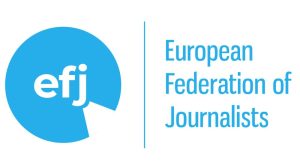Serb journalists in Kosovo face death threats, abuse and harassment online if they are perceived to veer too far from official Serbian policy.
It began as a case of ‘guilt’ by association.
When the Serbian-language website Alternativna, based in northern Kosovo, published an article exposing disinformation in a number of nationalist Telegram channels, the backlash targeted Alternativna collaborator Sanja Sovrlic, better known as a correspondent for the Serbian broadcaster N1.
Members of the Telegram channel Bunt Je Stanje Duha [Rebellion is a State of Mind] began hurling insults at Sovrlic and parsing an old post on her X profile from November last year in which she said it was time Serbia faced the “reality” in Kosovo, its majority-Albanian former province that declared independence in 2008.
Sovrlic, who reports from a predominantly Serb-populated pocket of northern Kosovo, stressed in the post that she did not think Serbia should necessarily recognise Kosovo as sovereign, but that life should be allowed to develop “in line with ‘reality’”.
Even that was too much for some Serbs who see Kosovo as the cradle of their Orthodox faith, particularly coming from a journalist at CNN-affiliated N1, a television news channel that is fiercely critical of Serbia’s current president and ruling party.
One of the Telegram users, hiding behind a pseudonym, wrote of waiting “for the day when their house will burn to the ground”, in reference to N1.
For Serb journalists reporting in Kosovo, such threats have become the norm as right-wing hardliners exploit new ways to abuse and intimidate those who dare to question official Serbian policy on Kosovo.
Serb journalists in Kosovo find themselves in an impossible situation – confronted every day with the ‘reality’ of living in a state recognised by more than 100 others, answerable to Kosovo law and probably in regular contact with Kosovo Albanian colleagues and Kosovo institutions, while simultaneously expected to support the official Serbian line that Kosovo remains an inviolable part of Serbian territory.
“N1 has already been labelled an ‘enemy” by those close to the authorities, so connecting Alternativna to me was a way to discredit the outlet, which is absurd considering N1 probably broadcasts more reporting on Kosovo and on the daily lives of Serbs here,” Sovrlic told BIRN.
“I didn’t feel personally threatened; on those Telegram channels, it’s only a matter of time before someone becomes the next ‘thorn in their side’ and gets targeted,” she said. “Sooner or later, anyone doing journalism here in a fair and professional way can become a target.”
Alternativna journalist and editor Ana Marija Ivkovic said Sovrlic was “an easy target”.
The perpetrators frequently pursue their targets online, in the form of hacking, phishing, DDoS attacks, surveillance and harassment.
Worsening media landscape
The safety of journalists, both Serb and Albanian, in northern Kosovo is a cause of growing concern, particularly since tensions soared in 2023 over the installation of Albanian mayors in four Serb-majority municipalities following a Serb boycott of local elections.
On the whole, the state of media freedom in Kosovo leaves much to be desired.
This year, Reporters Without Borders put Kosovo in 99th place on its global index on press freedom, 24 places lower than last year.
“While the Kosovo media market is diverse, its development is limited by its small size and ethnic divisions,” the media watchdog wrote. “Media freedom is threatened by politicised regulation, gag suits, insufficient access to public information and serious risks for the safety of journalists.”
Speaking of the Kosovo media situation in general, Xhemajl Rexha, head of the Association of Journalists of Kosovo, AJK, told BIRN: “Online harassment is the most common type of threat journalists face, via threatening messages or other ways of trying to interrupt their work.”
This was felt in March 2025 by Radio Gorazdevac, the only Serbian-language media outlet in the western Kosovo region of Peja/Pec, when a website called Srpski Glas [Serbian Voice] accused it of “serving independent Kosovo” and “violating the Constitution of Serbia” for referring to Kosovo’s president as ‘president’ and its prime minister as ‘prime minister’.
It called for a boycott of the radio and threatened legal action against its editor-in-chief, Darko Dimitrijevic, and his team.
“When such claims, rooted in manipulated narratives, start spreading across social media and Telegram channels, it’s more than defamation,” Dimitrijevic told BIRN. “It’s an attack on our professional integrity.”
Another Serb journalist, Dragana Vukosavljevic, said she had been threatened with legal action by a Kosovo Albanian municipal official in North Mitrovica in March 2023 over an article that named the official in connection with the suspension of birth and death registrations in the municipality.
In a statement issued by her employer, the north Kosovo media outlet KoSSev, Vukosavljevic quoted the official as telling her: “Delete my name immediately, or I will come with the police.”
Rexha, from the Association of Journalists, said journalists in Kosovo in general face “ongoing digital threats”.
“But our colleagues in the north are often targeted by both sides of the ethnic divide.”
This can involve publication of their personal information and contact details on social media, a phenomenon also affecting Kosovo Albanian journalists, with women often the target.
“This serves as a means to discourage them from the important work of reporting,” Rexha said.
“We have seen cases of attacks which disrupted the normal flow of work for the media, including those in the north,” he told BIRN, citing also the misuse of the KoSSev logo in August 2024 on fake content that included, among other things, death threats.
“They included hate speech, and that made this media a further target of threats and intimidation,” said Rexha.
Many journalists remain ill-equipped to deal with such cyber threats, he said.
“My sense is there is a great lack of knowledge on the topic from journalists, who most often ignore the threats they get and are not aware how to handle them.”
Lack of protection, lack of trust
Part of the problem is money, said Milica Radovanovic from the North Mitrovica-based New Social Initiative, NSI, citing the fact that most Serbian-language media rely on project-based donor support and therefore lack long-term stability.
“The lack of sustainable funding primarily threatens the very survival of local media, which, despite numerous challenges, continuously prove to be one of the most professional sources when it comes to reporting from Kosovo,” Radovanovic told BIRN.
Sovrlic also described Serbian-language media in Kosovo as “among the most professional in the region”.
Their fragile funding situation, however, limits the ability of newsrooms to protect their staff.
“The absence of stable financial support not only complicates the day-to-day functioning of newsrooms, but also indirectly affects the safety of journalists, their motivation, and their ability to consistently uphold high professional standards,” Radovanovic said.
Questionnaires conducted with journalists, editors, and digital security experts indicate that digital safety remains a secondary consideration within broader media protection efforts in Kosovo.
“A lot of the time, it really feels like you’re completely on your own,” said one respondent, a young Serb journalist who gave her name as Katarina.
Only a small number of journalists have access to regular, structured digital safety training.
“Many of us use basic tools like VPNs or two-factor authentication,” said another, called Sandra. “But without proper training, it’s hard to know whether we’re really protected or just doing the minimum.”
In the absence of a coordinated framework, many journalists address digital threats independently.
The Council of Europe says states should put in place comprehensive national strategies of prevention, legal remedy and institutional coordination to protect against digital threats. Kosovo, however, is not yet a member of the CoE.
“You don’t need expensive tech, just awareness, discipline, and a few trusted methods,” Pristina-based cybersecurity expert Besnik Limaj told BIRN. He recommended strong passwords, two-factor authentication, and encrypted communication as essential first steps, and called for digital security training in every newsroom.
None of that is likely to stop the kind of smear campaigns faced by Sovrlic, Alternativna, or Radio Gorazdevac, however.
“Journalists were targeted in attacks on social networks, mainly because of the content they published or the topics they covered,” said Radovanovic from NSI.
These attacks “typically involve insults, discrediting, and coordinated campaigns aimed at intimidating or discouraging them from continuing their work.”
At Radio Gorazdevac, Dimitrijevic said his outlet had done nothing wrong.
“We may not be the biggest or most polished media outlet, but we proudly stand behind everything we’ve published in the last 25 years,” he said. “Behind every article, every report, every story, there is a name and a surname. We don’t hide.”
Source: BalkanInsight




